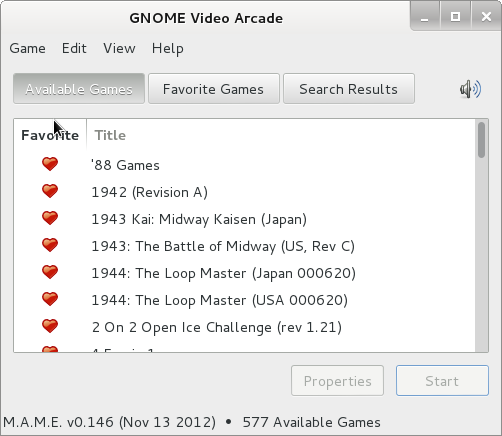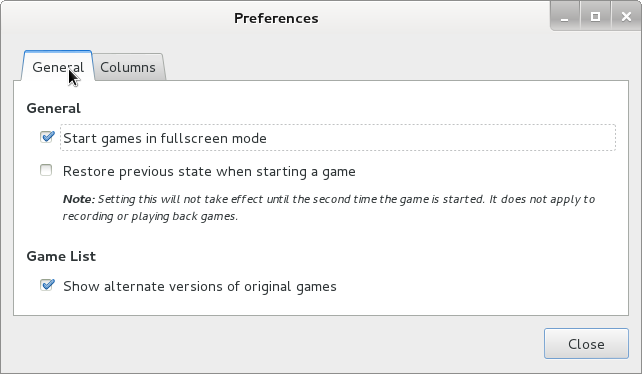
To play the good old arcade on Debian Linux in previous releases I used GNOME's xmame frontend gxmame in Debian 5.0 Lenny and in Debian 6.0 gxmame was no longer working fine so I was using a KDE package frontend called kamefu.
Yesterday I just re-installed my laptop with latest stable Debian 7 Wheezy and after installing re-installing all packages I regularly use it happened gxmame and kamefu are no longer available in Debian 7. It was kinda of shocking since I already so much get accustomed to kamefu that I don't want to switch to other Mame GNOME GUI frontend.
I tried building kamefu from source (btw kamefu is still in very early development stage 0.1 with no luck). After the epic fail and my laziness to look for what kind of header files part of KDE I have to install. I read what is written on Mame in Debian Wiki here and found out about existence of new package in Debian 7 – gnome-video-arcade, as well understand the so far well knon xmame package is substituted by one called mame. Though name changed mame is not much different from xmame. In theory mame pack should be complete substitute for xmame but in practice my experiments showed xmame was running much more ROM files than the new mame binary.
Here is what I did to have running most of my Mame ROm files on Debian 7 Linux;
1. Install mame gnome-video-arcade, mame-tools and xmame-tools debs
noah:~$ apt-get --yes install mame mame-tools xmame-tools
...
2. Create default config file for mame bin
noah:~$ cd .mame
noah:~/.mame$ mame -cc
mame -cc command generates mame.ini config file;
noah:~/mame$ ls -al mame.ini
-rw-r--r-- 1 hipo hipo 6660 май 25 18:31 mame.ini
3.Add location to Mame Rom files in config file
noah:~/mame$ vim mame.ini
Near beginning of file there is section:
#
# CORE SEARCH PATH OPTIONS
#
rompath $HOME/mame/roms;/usr/local/share/games/mame/roms;/usr/share/games/mame/roms;
At the end of rompath include location of MAME ROMs in my case ROMS are located in;
/disk/Games/Mames/roms
rompath $HOME/mame/roms;/usr/local/share/games/mame/roms;/usr/share/games/mame/roms;/disk/Games/Mames/roms;
Further on to test which ROMS will work and which not compatible;
noah:~/mame$ mame -verifyroms |grep -i good
1941j : yi22b.1a (279 bytes) - NOT FOUND - NO GOOD DUMP KNOWN
romset 1942a [1942] is good
1943 : bm.7k (65536 bytes) - NOT FOUND - NO GOOD DUMP KNOWN
1943kai : bm.7k (65536 bytes) - NOT FOUND - NO GOOD DUMP KNOWN
1943u : bm.7k (65536 bytes) - NOT FOUND - NO GOOD DUMP KNOWN
romset 1944 is good
romset 1944j [1944] is good
romset 280zzzap is good
romset 3kokushi is good
romset 3stooges is good
romset 4dwarrio is good
.....
4. Launch gnome-video-arcade binary
noah:~/.mame$ gnome-video-arcade
On first run, you will have to wait a about 10 minutes for program to Index all Rom files it loads up the CPU severely and looks like the program is hanged …

As you can see the interface is very simplistic, there is Preferences (menu) but there is almost nothing to configure;

AA
 One very unpleasent thing is many of the best games didn't work anymore. Some great arcade games like Punisher, Captain Command, Cadillacs and Dinosaurs who worked perfectly fine on old xmame + kamefu, don't work anymore with mame + gnome-video-arcade.
One very unpleasent thing is many of the best games didn't work anymore. Some great arcade games like Punisher, Captain Command, Cadillacs and Dinosaurs who worked perfectly fine on old xmame + kamefu, don't work anymore with mame + gnome-video-arcade.
Besides its simplicty gnome-video-arcade has the precious feature to Record Played Games. To record yourself playing and later replay it use menus;
Game -> Record
or use shortcut (CTRL+R)





